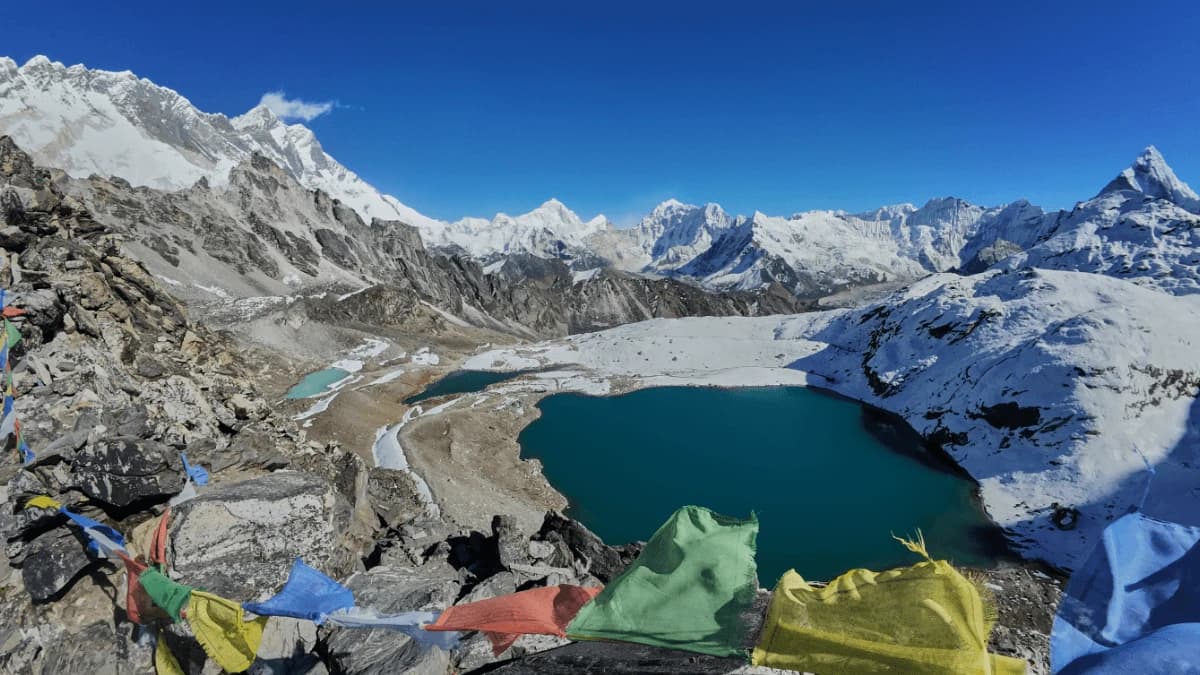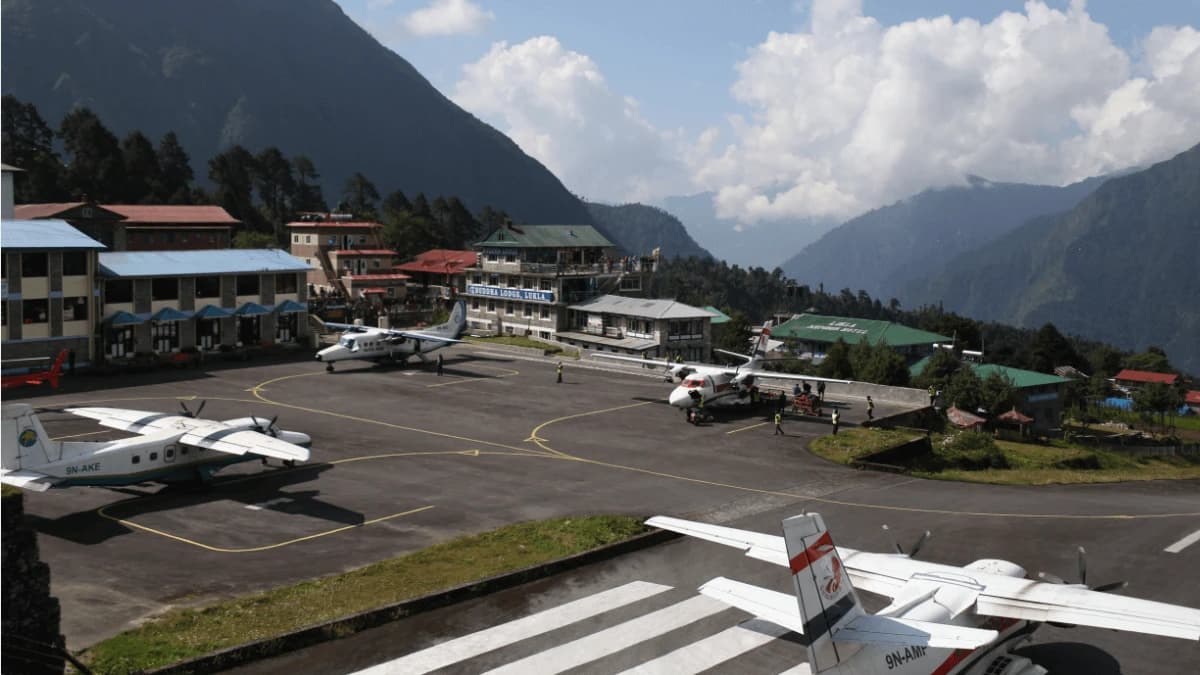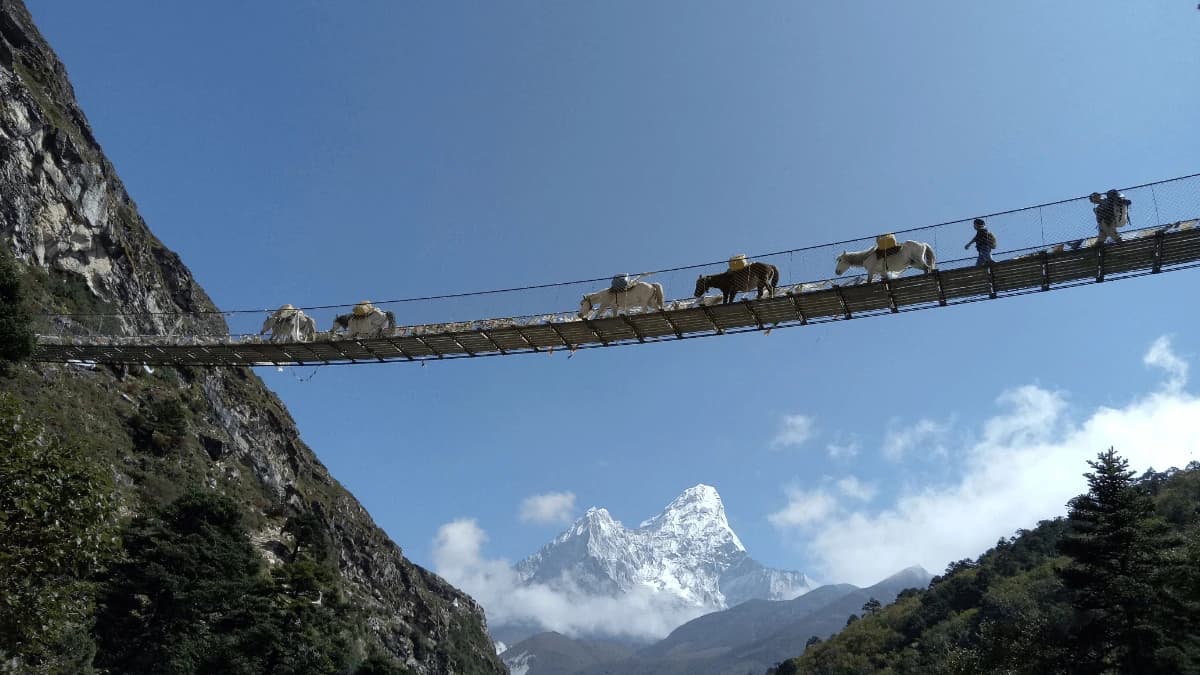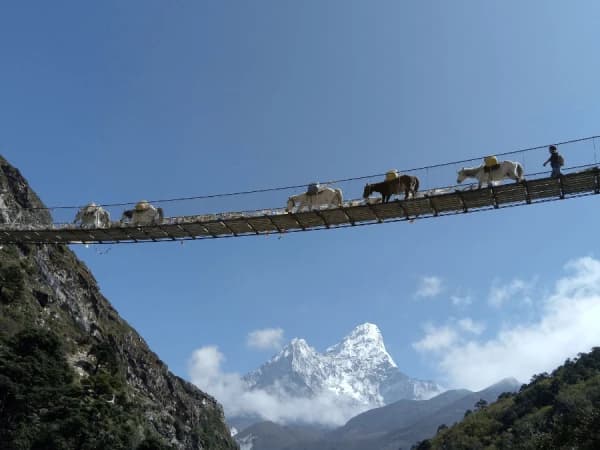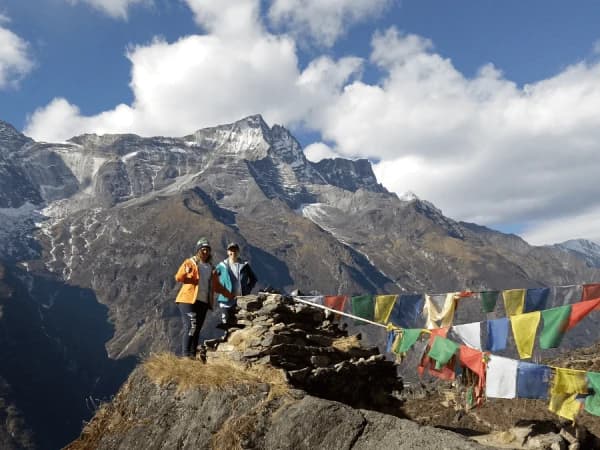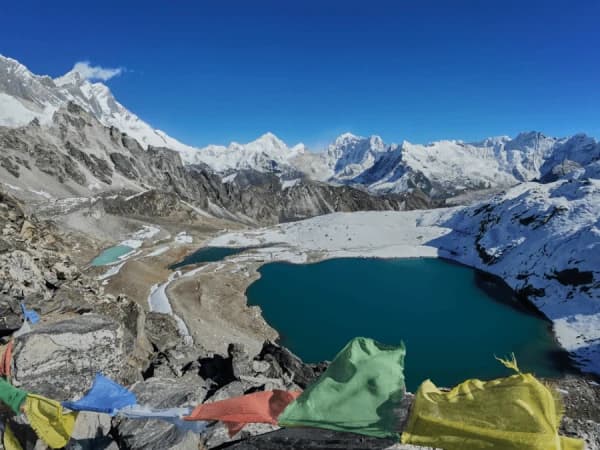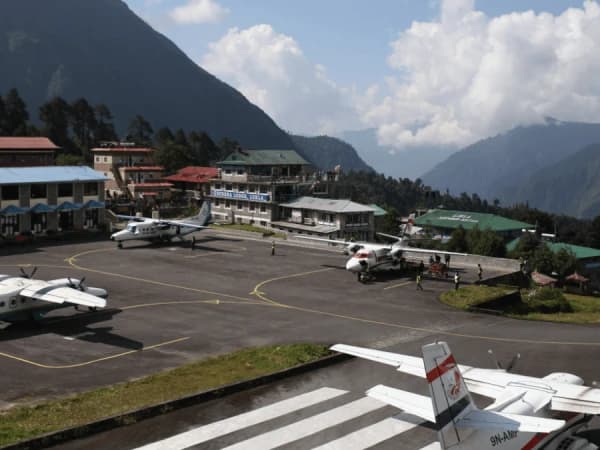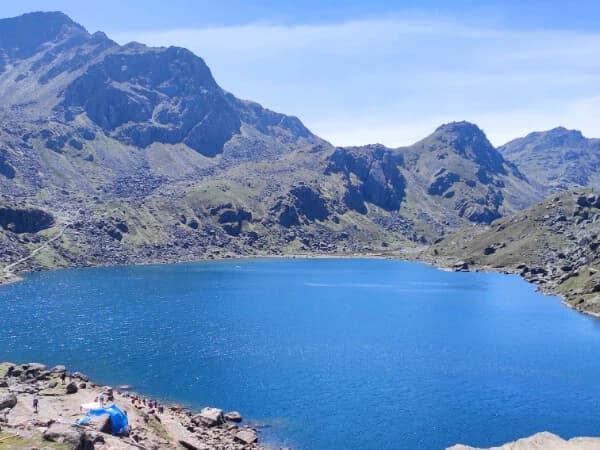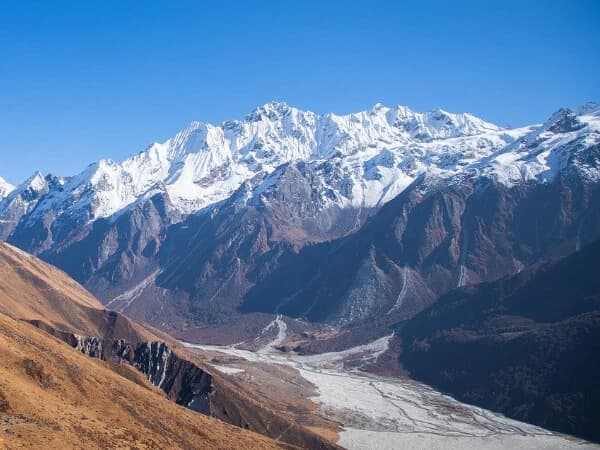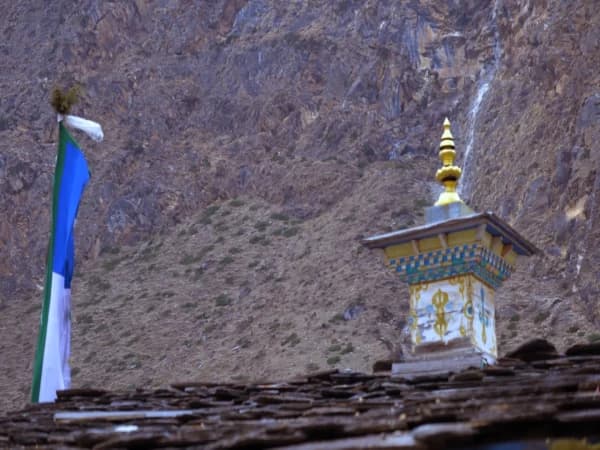This 18‑day, strenuous high‑altitude circuit trek around Everest starts and ends in Kathmandu, includes flights to/from Lukla, and traverses the three famed passes: Kongma La (5,535 m), Cho La (5,420 m), and Renjo La (5,360 m) while visiting Everest Base Camp, Kala Patthar, Gokyo Lakes, and Sherpa villages.
Everest Three Passes Trek
Everest Three Passes Trek Highlights: What to Expect on the Journey
- Visit to UNESCO World Heritage Sites in Kathmandu
- Scenic flight to Lukla
- Beautiful prayer wheels, colorful prayer flags, mani stones in the trekking route
- Kongma La Pass (5,535m) – The highest pass, offering a panoramic view of Makalu, Lhotse, and Ama Dablam.
- Cho La Pass (5,420m) – A thrilling glacier crossing connecting Everest Base Camp with Gokyo Valley.
- Renjo La Pass (5,360m) – One of the most spectacular viewpoints in the Everest region, overlooking Gokyo Lakes and Mount Everest.
- Everest Base Camp (5,364m) – A bucket-list experience for trekkers, offering up-close views of Everest.
- Kala Patthar (5,545m) – An amazing panoramic view of the Everest region
- Gokyo Lakes & Gokyo Ri (5,357m) – A series of stunning turquoise lakes nestled amid high-altitude peaks, with a breathtaking viewpoint at Gokyo Ri.
- Ngozumpa Glacier – The longest glacier in the Himalayas, creating a dramatic landscape of ice formations and rocky debris.
- Tengboche Monastery – The most significant Buddhist monastery in the Khumbu region, framed by a perfect view of Ama Dablam.
- Namche Bazaar – The vibrant Sherpa capital, known for its cultural richness, mountain markets, and incredible views.
The Everest Three High Passes Trek is a challenging and rewarding Himalayan adventure. It offers a unique opportunity to traverse three of Nepal’s highest mountain passes: Kongma La (5,535m), Cho La (5,420m), and Renjo La (5,360m). This trek is designed for experienced trekkers who seek an off-the-beaten-path journey, covering some of the most breathtaking and remote regions of the Khumbu Valley.
Unlike the classic Everest Base Camp Trek, this route takes a circuitous path through high-altitude landscapes, including glacial valleys, rugged moraines, pristine alpine lakes, and towering Himalayan peaks. The trek connects the famous Everest Base Camp (5,364m), Kala Patthar (5,545m), and Gokyo Lakes, providing diverse and awe-inspiring scenery throughout the journey, offering unparalleled panoramic views of the beautiful gigantic peaks, including Mount Everest, Mount Lhotse, Mount Makalu, and Mount Cho Oyu.
Along the way, trekkers pass through historic Sherpa settlements such as Namche Bazaar, Tengboche, Dingboche, Lobuche, Gokyo, and Thame, offering a deep insight into Sherpa culture, Tibetan Buddhist traditions, and high-altitude lifestyles. Monasteries, prayer flags, and chortens mark the trail, reinforcing the spiritual essence of the Himalayas.
Unlike the standard Everest Base Camp route, this trek is a full circuit that loops through less-traveled paths, making it ideal for those looking to escape the crowds. The journey offers a mix of breathtaking landscapes, cultural encounters, and extreme high-altitude challenges, making it one of the most rewarding Himalayan experiences for adventure seekers, promising the adventure of a lifetime.
This trek is a true test of endurance and resilience, but for those who complete it, the rewards are unparalleled. From standing at the base of the world’s highest mountain to crossing frozen glaciers and witnessing sunrises over Everest, this journey promises the adventure of a lifetime.
Everest Three High Passes
The Three High Passes of the Everest region, Kongma La (5,535m), Cho La (5,420m), and Renjo La (5,360m)—offer an adventurous route connecting different valleys and landscapes. These passes provide stunning panoramic views of Everest, Lhotse, Makalu, and Cho Oyu, along with dramatic glaciers, turquoise lakes, and remote Himalayan trails. Crossing them requires strong endurance, proper acclimatization, and trekking experience, as they involve steep ascents, rocky terrain, and sometimes icy conditions, especially during colder months. Nevertheless, with the right preparation and support, even a novice trekker can take on the Everest Three High Passes Trek.
Kongma La is the highest and most challenging pass, linking Chhukung and Lobuche, with a steep climb over the glacial moraine. Cho La connects Dzongla and Gokyo, featuring a glacier crossing that often requires crampons. Renjo La, the easiest of the three, provides breathtaking views of Gokyo Lakes and Everest before descending to Thame and Namche Bazaar. Together, these three high passes create a thrilling circuit through the Everest region, attracting trekkers seeking a more demanding and less-traveled alternative to the standard Everest Base Camp trek.
Why Opt for the Everest Three Passes Trek Instead of Other Treks?
Adventure seekers often consider popular routes like the Everest Base Camp Trek or the Gokyo Lakes with Chola pass Trek when planning a trek in the Everest region. While both provide stunning Himalayan experiences, the Everest Three Passes Trek stands out as Nepal's most thrilling and comprehensive trekking adventure. This route is perfect for those seeking an immersive, high-altitude journey that combines breathtaking scenery, remote trails, and physical challenges. Here’s why this trek is the ultimate choice over other popular routes:
The Ultimate High-Altitude Trekking Challenge
Unlike the Everest Base Camp Trek, which follows a single well-trodden path, the Everest Three Passes Trek pushes trekkers to cross three demanding high-altitude passes—Kongma La (5,535m), Cho La (5,420m), and Renjo La (5,465m). Each pass presents steep ascents, rugged terrain, and glacier crossings, making this trek ideal for experienced hikers looking to test their endurance in Nepal’s most challenging trekking route. The diverse and dramatic landscapes encountered along the way make it one of the most rewarding trekking adventures in the Himalayas.
Unmatched Panoramic Views and Varied Landscapes
While treks like Everest Base Camp and Gokyo Lakes offer spectacular views, the Three Passes Trek combines the best of both. Trekkers get uninterrupted panoramas of Everest, Lhotse, Makalu, Cho Oyu, and Ama Dablam from multiple vantage points, including Kala Patthar, Gokyo Ri, and each high pass. The Renjo La Pass in particular offers one of the most breathtaking views of Gokyo Lakes, surpassing even the famous Kala Patthar viewpoint. From glaciers and alpine valleys to pristine lakes and high mountain passes, this trek showcases the diverse landscapes of the Everest region in one ultimate expedition.
A Deeper Exploration of the Khumbu Region
The Three Passes Trek ventures beyond the standard trails, allowing trekkers to explore hidden valleys, remote villages, and lesser-visited parts of the Khumbu region. Along the way, you’ll pass through vibrant Sherpa settlements, visit the historic Tengboche Monastery, and experience the rich Buddhist culture of the Himalayas. Unlike the crowded EBC route, this trek offers a more authentic and peaceful experience, giving you a chance to interact with locals and witness the traditional Sherpa way of life.
The Ultimate Adventure for Experienced Trekkers
For trekkers looking to push their limits, the Everest Three Passes Trek is the perfect challenge. With multiple high-altitude crossings, glacial paths, and altitudes exceeding 5,000 meters, this trek demands strong physical endurance and acclimatization. The sense of achievement after conquering each pass is unmatched, making it the best choice for adventure seekers looking to go beyond the usual trekking routes. Every step brings new challenges, but the reward is an unforgettable Himalayan experience unlike any other.
The Most Complete Everest Experience
While the Everest Base Camp Trek is an excellent choice for first-time trekkers, it primarily focuses on reaching one iconic destination. The Gokyo Lakes Trek, on the other hand, highlights the beauty of the Gokyo Valley but lacks the extensive exploration found in the Three Passes Trek. By choosing this route, trekkers get to experience the best of both worlds and more, reaching Everest Base Camp, enjoying stunning views from Kala Patthar, exploring the turquoise Gokyo Lakes, and crossing three thrilling high passes. This makes it the best-rounded trek in the Everest region, offering a perfect blend of adventure, scenery, and cultural immersion.
What awaits you during the Everest High Passes Trek?
- Spectacular Himalayan Panoramas & Hidden Trails: The Everest Three High Passes Trek offers some of the most breathtaking mountain views in the Himalayas. From each high-altitude pass—Kongma La (5,535m), Cho La (5,420m), and Renjo La (5,360m)—you’ll witness stunning panoramas of Everest, Lhotse, Makalu, and Cho Oyu. This route also takes you through off-the-beaten-path trails, allowing you to explore hidden gems of the Everest region that remain untouched by the usual trekking routes.
- Scenic Villages & Cultural Encounters: This trek provides a deeper cultural experience as it passes through picturesque valleys and charming Sherpa villages. You’ll have the opportunity to interact with local communities, experience their traditional way of life, and visit iconic Buddhist monasteries such as Tengboche Monastery. The warmth of the Sherpa hospitality makes this trek even more enriching.
- Diverse Landscapes & Thrilling Terrain: The journey begins in dense rhododendrons and pine forests, home to diverse Himalayan flora and fauna. As you ascend, the landscape transitions into rugged alpine terrain with glacial moraines, rocky trails, and snow-covered passes. The contrast between the lush lower trails and the harsh beauty of the high-altitude region makes this trek truly unique.
- Challenging Climbs & Rewarding Views: One of the most demanding sections of the trek is the ascent from Tengboche (3,860m) to Dingboche (4,410m) and then to Kongma La Pass (5,535m)—the highest and most challenging of the three passes. The effort is well worth it, as the views from Kongma La are simply unforgettable.
- Reaching Everest Base Camp & Kala Patthar: The trail then leads to Everest Base Camp (5,364m) via Gorak Shep, a historic stop for trekkers and climbers. A short hike from Gorak Shep takes you to Kala Patthar (5,545m), one of the best vantage points for breathtaking close-up views of Everest. This spot is famous for its sunrise and sunset views over the world's highest peaks.
- Conquering the Cho La Pass – The Toughest Challenge: Descending from Everest Base Camp, trekkers face Cho La Pass (5,420m), the most technical and demanding pass of the three. The route, starting from Lobuche Kharka to Thangnak, involves steep climbs, icy paths, and rocky terrain, requiring careful navigation. However, the panoramic scenery of the surrounding glaciers and peaks makes the challenge worthwhile.
- Renjo La Pass – A Hidden Gem with Jaw-Dropping Views: After reaching Gokyo Ri, one of the most scenic viewpoints in the Everest region, the trek continues toward Renjo La Pass (5,360m). This pass offers even more spectacular views of the Gokyo Lakes and the Himalayan giants, making it a highlight of the entire trek. From here, you descend towards High Camp and eventually rejoin the main trail to Namche Bazaar, completing the full circuit.
Are You Ready for the Everest Three High Passes Trek?
The Everest Three High Passes Trek is one of the most challenging yet rewarding trekking adventures in Nepal. While it requires crossing three high-altitude mountain passes, technical climbing skills are not necessary. Trekkers with good physical fitness and prior trekking experience can complete this journey successfully. However, it is recommended for beginners to prepare themselves to walk through the rugged trails, adjust to the higher altitudes, and tolerate extreme weather conditions demanding a high level of endurance, stamina, and acclimatization.
However, this trek is best suited for those trekkers who can handle the steep ascents, glacier crossings, and rocky paths above 5,000 meters. The route includes challenging sections over unstable moraines, ice-covered trails, and sharp rocky inclines, making it one of the toughest treks in the Everest region. If you’re an adventure enthusiast looking for an adrenaline-filled Himalayan journey, this trek is well-matched for you to enjoy breathtaking landscapes, cultural immersion, and the thrill of conquering three iconic mountain passes.
Basic Recommended Preparation for the Everest Three High Passes Trek
Proper preparation is the vital key to efficaciously completing the Everest Three High Passes Trek. Since this is a physically demanding and remote expedition, you need to focus on fitness, acclimatization, and gear selection before setting off on your adventure. Here’s how you can prepare effectively:
Build Your Physical Fitness
- Engage in cardio exercises like running, cycling, or swimming to improve stamina.
- Strength training for legs, core, and endurance will help tackle steep climbs.
- Hiking on rough terrain with a loaded backpack is highly recommended.
Acclimatization and Altitude Training
- Plan a gradual ascent and include extra acclimatization days.
- If possible, train at high-altitude locations before your trek.
- Learn to recognize symptoms of altitude sickness and be prepared to respond.
Pack the Right Gear
- Bring high-quality trekking boots, layered clothing, gloves, and thermal wear for extreme cold.
- Essential gear includes a down jacket, sleeping bag (rated for -20°C), trekking poles, and UV-protection sunglasses.
- Carry snacks, a hydration system, and altitude sickness medication for emergencies.
Plan Your Trekking Logistics
- Decide whether to trek independently or with a guide and porter.
- Obtain necessary permits, including the Sagarmatha National Park Permit and TIMS Card.
- Be mentally prepared for unpredictable weather, long trekking days, and high-altitude conditions.
Everest Three High Passes Trek Cost for 2025 and 2026
The Everest Three High Passes Trek cost for 2025 and 2026 varies depending on several factors, including the trekking company, duration, and services included. On average, the cost of the trek ranges between USD 1,800 and USD 3,500. This includes essential services like guide and porter fees, trekking permits, accommodation, and meals during the trekking period. However, the price can increase with added services such as luxury accommodations, private guides, and international flight costs. Be sure to budget for extra expenses like travel insurance, gear rental, and tips for guides and porters, which are generally expected.
For a quick response, feel free to WhatsApp or Viber us anytime. You can inquire through our email.
Everest Three Passes Trek Itinerary
Start an unforgettable adventure with Recreation Holidays as we guide you through the Everest Three Passes Trek. This trek is among the most challenging yet rewarding experiences in the Everest region. We offer two routes, each leading to the same spectacular high-altitude passes. The key difference lies in the altitude gain and acclimatization schedule, ensuring a safer and more enjoyable journey.
To tackle the extreme elevations of the Everest Three Passes Trek, proper acclimatization is crucial. Our recommended counterclockwise itinerary ensures gradual altitude adaptation for a safer trek. Below is our 17-day itinerary outline, which can be customized to meet your preferences.
Upon landing at Tribhuvan International Airport, you will be greeted by our representative from Recreation Holidays, who will assist with your transfer to a comfortable hotel in the lively Thamel area. You can take the day to rest, explore the bustling streets filled with trekking shops, cafes, and cultural sites, or visit our office for a detailed trek briefing.
The journey begins with a thrilling 30–40-minute flight to Lukla, a gateway to the Everest region from Kathmandu Domestic Airport. Upon arrival, you will start your trek by descending through pine forests, crossing suspension bridges over the Dudh Koshi River, and passing traditional Sherpa villages. As you reach Phakding, you’ll be welcomed by cozy teahouses nestled in the valley. You will acclimate as you continue walking towards Phakding. On the way, you can visit Pemacholing and Rimishung Monastery while descending from Chheplung to Phakding. Overnight stay in Phakding.
Trek Duration: 3–4 hours (7.8 km)
Today’s trek takes you deeper into the Everest region, crossing several suspension bridges, including the iconic Hillary Suspension Bridge. Passing through Monjo, you will enter Sagarmatha National Park, where your permits will be checked. During the trek, you will enjoy the amazing views of the surrounding forests. The final ascent to Namche Bazaar is steep but rewarding, offering the first distant glimpse of Mt. Everest. Namche Bazar is the business center of Everest Trekking.
Trek Duration: 6–7 hours (10.4 km)
A crucial rest day in Namche allows your body to adjust to the increasing altitude. This day is set for Acclimatization. You can utilize your day by exploring the vibrant town, visiting the Sherpa Museum, or hiking to the Everest View Hotel for stunning panoramas of Everest, Lhotse, and Ama Dablam. This day also offers an opportunity to experience Sherpa culture and their way of life. There is a Sherpa Museum where you can learn more about Sherpas and trekking. You can get ATMs, Cyber cafes, and coffee shops here in Namche Bazaar.
Trekking through lush forests filled with rhododendrons, you’ll enjoy mesmerizing mountain vistas. The trail passes through small settlements before reaching Tengboche, home to the largest monastery in the Khumbu region. Take a short break to visit Tengboche Monastery and witness the monks chanting prayers amid the serene mountain backdrop of Mt. Everest, Mt. Ama Dablam, Mt Nuptse, and Thamserku. The zigzag trails leading towards Tengboche are tiring but rewarding as well. Arriving at Tengboche, you can rest in the teahouse, enjoy dinner, and get ready for the next day.
Trek Duration: 4–5 hours (8.6 km)
Descending through forests, you’ll cross the Imja Khola River before climbing to Pangboche, the highest permanent Sherpa village. The landscape begins to shift from dense forests to alpine terrain, ultimately leading you to the beautiful views of the Kangtega range, Thamserku, Ama Dablam, Taboche, Kwangde, Tengboche, Lhotse, Nuptse, and many more. Arriving in Dingboche, you will be surrounded by a dramatic landscape of snow-covered peaks and open fields. Before arriving at Dingboche, you can see Mt. Pumori's coronal ridge. Dingboche is the final destination for today, where you will spend the night.
Trek Duration: 5–6 hours (10.7 km)
As you continue your three high passes trek, follow the scenic Imja Khola Valley, surrounded by towering peaks and glacial moraines. It is a shorter trek today for a 3 to 4-hour descent offering the stunning views of Lhotse and Ama Dablam, leading to the herding settlement of Yak Bibre. From the terminal moraine, you’ll see the rocky, icy face of Imja Tse (Island Peak). Today's shorter duration walk allows you to relax or trek to Chhukung Ri for breathtaking mountain views, helping you acclimate for the next day’s ascent to Kongma La Pass. Overnight in Chhukung.
Trek Duration: 3–4 hours (4.5 km)
This day features the highest pass on the trek, Kongma La, a demanding ascent over rugged terrain. The summit rewards trekkers with awe-inspiring views of Nuptse, Makalu, and the glacial moraines of the Khumbu Glacier. A steep descent leads to Lobuche. You’ll venture into remote alpine terrain with no teahouses, so carry plenty of water.
You have two route options: ascend northwest from Chhukung to the Nuptse Glacier or follow the high trail above Niyang Khola via Bibre Valley. Along the way, enjoy breathtaking views of Island Peak Valley and the rugged Amphu Lapcha. The rocky path leads to a vast basin dotted with ice lakes along Niyang Khola. After a challenging 5-hour ascent, you’ll conquer Kongma La, the highest of the three Everest passes, marked by waving prayer flags. The descent is steep and demanding, taking you over the glacial moraine before reaching Lobuche, your final stop for the day.
Trek Duration: 8–9 hours (7.7 km)
The 3 High Passes trek takes you through the Khumbu Glacier's moraine, leading you toward Gorakshep. As you pass the iconic pyramid landmark, you’ll be treated to stunning views of Everest’s north ridge, including Mt. Pumori, Mt. Mahalangur, Mt. Lingtern, Mt. Khumbutse, and Mt. Nuptse. Upon reaching Thangma Riju, you’ll be able to take in a 360-degree panorama of snow-covered peaks. From the summit of Changri Glacier, you’ll enjoy a view of Kalapatthar, a grassy plateau beneath Mt. Pumori. Upon arrival in Gorakshep, you’ll be surrounded by towering snow-capped mountains, including the world’s highest peak, Mount Everest. The trek continues past Gorak Shep Lake and memorials dedicated to Indian army mountaineers before reaching Everest Base Camp. As you approach the base, you'll understand the perilous nature of the Khumbu Icefall trail. Though Everest itself may not be visible from Base Camp, the breathtaking sight of Nuptse and Khumbutse rising above the mountaineers' vibrant tents is equally impressive. This marks the climax of your journey. Afterward, you'll return to Gorakshep to spend the night.
Trek Duration: 3–4 hours (5.2 km)
This is the highlight of your Everest 3 High Passes trek, starting with a walk to Kalapatthar for a stunning sunrise view. After a few hours of trekking, you’ll reach Kalapatthar, where you can enjoy panoramic views of the Himalayas. From this vantage point, you'll see Everest, Lhotse, Nuptse, Pumo Ri, Ama Dablam, Khangtenga, Lobuche Peak, Everest Base Camp, and the Khumbu Glacier and Icefalls. The memories and photos you capture here will last a lifetime. Afterward, head back to Gorakshep to pack up, then retrace your steps to Lobuche, following the beautiful trail to Dzongla. You will stay overnight at Dzongla.
Trek Duration: 7–8 hours (11.5 km)
A challenging yet exhilarating climb over icy terrain leads to Cho La Pass, rewarding trekkers with stunning mountain panoramas before descending into Thagnak.
To catch a glimpse of the stunning Cholatse, an early start is necessary. The most challenging part of the Everest 3 High Passes trek begins as you pass through Dzongla, traveling through dense woodland before descending into a basin. As you ascend again, you'll be rewarded with a spectacular view of Chola Lake and Mt. Ama Dablam. The steep climb is tough, with rocks adding to the difficulty, leading to the winding Bergschrund paths. From the summit, you'll enjoy breathtaking views of surrounding peaks, framed by fluttering prayer flags. The descent to Thagnak is relatively straightforward, unless ice covers the rocks, making the path hazardous. You will spend the night in Thagnak.
Trek Duration: 7–8 hours (8 km)
Crossing the Ngozumpa Glacier, you’ll reach the serene Gokyo Lakes, a highlight of the trek known for its striking turquoise waters. You will have to start early this morning. The Ngozumpa Glacier is the longest glacier of Nepal, while Gokyo Lake is a beautiful lake comprising six lakes, which are the world's highest freshwater lake system, and Thonak Lake is the largest among them.
Trek Duration: 2–3 hours (2.7 km)
Enjoy a scenic acclimatization day in Gokyo, featuring a rewarding hike to Gokyo Ri, one of the best vantage points in the Everest region. From the summit, you’ll witness breathtaking panoramic views of Everest, Lhotse, Cho Oyu, and Makalu. This day also offers an opportunity to explore Gokyo's pristine glacial lakes.
A short trek north leads to the fourth lake, surrounded by dramatic cliffs and peaks, followed by the fifth and largest lake, a brilliant azure gem with awe-inspiring reflections of the Himalayas. Adventurous trekkers can ascend the slopes near the lake for unparalleled views of Cho Oyu, Gyachung, Everest, Lhotse, Nuptse, and Makalu. Beyond this, the Cho Oyu Base Camp offers another incredible panoramic view. If time and energy allow, you can continue to the sixth lake, adding an extra dimension to your adventure.
Begin the day with an early morning ascent to Renjo La Pass, following a less-traveled but scenic Renjo trail through Dudh Pokhari. After approximately three hours of challenging trekking, you’ll be rewarded with mesmerizing panoramic views of Everest, Lhotse, Cholatse, and Taboche. Reaching the Renjo La Pass unveils a stunning 360-degree view of Mt. Cho Oyu and the adjacent Himalayan peaks.
The descent takes you past Angladumba Tsho, Relama Tsho, and Renjo Lake, navigating through a valley dotted with enormous boulders before reaching Lumde. A final stretch of an hour’s trek brings you to Marlung, where you will spend the night in a cozy tea house.
Trek Duration: 6–7 hours (7.4 km)
Descend from Marlung to Thame, following an ancient Tibetan trade route along the Bhote Koshi River. The journey passes through Taranga and Langmuche Khola, where you can admire Thamserku, Katenga, and Kusum Kangguru peaks.
At Thame, visit the renowned Thame Monastery, a historic Buddhist gompa set against a stunning mountain backdrop. Crossing a suspension bridge, you’ll reach Samde, a picturesque spot with breathtaking Himalayan views. The trek continues through Thamo, home to Khari Goma Monastery, before passing the world’s highest hydropower plant—a remarkable engineering feat. As you descend through Phurte, you will pass Laudo Monastery, prayer flags, chortens, mani walls, and ancient Buddhist shrines, leading you back to the lively town of Namche Bazaar.
Trek Duration: 7–8 hours (11.5 km)
The final trekking day of the Everest Three High Passes Trek takes you from Namche to Lukla, marking the conclusion of your Himalayan adventure. The descent can be physically demanding, as you navigate a steep and rugged trail with tired legs.
Moving carefully, you will cross the Dudh Koshi River via suspension bridges, passing through lush alpine forests and charming Sherpa villages. The route becomes gentler as you progress, revealing picturesque landscapes filled with rhododendron and pine forests, vast open plains, and distant snow-capped peaks.
As you approach Lukla, you’ll be immersed in the rich Buddhist culture, passing monasteries, mani walls, and prayer wheels along the way. Upon arrival, take time to celebrate the completion of your incredible trekking journey before spending your final night in the mountains.
Today, you will take a scenic flight from Lukla to Kathmandu, marking the conclusion of your Everest Three High Passes Trek. Since Lukla to Kathmandu flights are usually scheduled in the morning due to unpredictable Himalayan weather—including strong winds and low visibility—there is always a chance of flight delays or cancellations. To avoid disruptions to your travel plans, it is advisable to have an extra contingency day.
Upon arriving in Kathmandu, you can unwind after your adventurous trekking journey by exploring the city's cultural sites, relaxing at your hotel, or indulging in some well-deserved celebrations. In the evening, enjoy a farewell dinner in Thamel, the heart of Kathmandu’s vibrant nightlife, as you reflect on your incredible trekking experience. You will stay overnight at a comfortable hotel, cherishing the memories of your Himalayan adventure of the Everest high passes.
Today marks the final departure from Kathmandu, concluding your unforgettable journey. Our representative from Recreation Holidays will assist you with a smooth airport transfer, picking you up from your hotel and dropping you off at the international terminal at least three hours before your scheduled flight.
If you wish to extend your adventure, you can opt for another exciting travel package to explore more of Nepal’s breathtaking landscapes and cultural heritage. Whether you continue your journey or head home, your time in the Himalayas will leave you with lasting memories. Safe travels!
Trip Service Details
Includes
- Pick-up from Kathmandu International Airport upon arrival.
- 2 nights' accommodation at a 3-star hotel in Kathmandu with breakfast.
- All required permits for the Three High Passes Trek.
- Accommodations during the trek in a twin-sharing basis in teahouses.
- 3 meals daily (breakfast, lunch, and dinner) throughout the trek.
- Trekking gear duffel bag for your belongings.
- English-speaking guide with First Aid training.
- Flights to Lukla and Kathmandu, including airport transfers.
- Staff insurance, salary, food, and accommodation.
- Oximeter for checking pulse oxygen saturation and heart rate (important for monitoring altitude sickness).
- Purified drinking water with Ef-Chlor purification tablets.
- Free luggage storage at the Recreation Holidays store during the trek.
- Certificate of achievement (if requested).
- Farewell dinner at a Nepali restaurant in Thamel before departure.
- Airport transfer for your final departure from Nepal.
Excludes
- International airfare, Nepal visa fee and any personal insurance.
- Extra accommodation and meals in Kathmandu.
- Porter services (one porter for every two trekkers is recommended and USD 360 per porter, 20-25 KG max).
- Personal expenses on the trek (hot showers, drinks, extra meals, Wi-Fi/Data, battery charging, accommodation upgrades)
- Tips for the staff (expected)
- Anything not mentioned in the "INCLUSION" section
Additional Info
Best Time for Everest Three Passes Trek
Timing plays a crucial role in the success and safety of the Everest Three High Passes Trek. The ideal seasons are:
- Spring (March to May) – Pleasant temperatures, clear skies, and blooming rhododendron forests create a picturesque trekking experience. The pre-monsoon season also attracts climbers preparing for Everest expeditions, adding an energetic vibe to the region.
- Autumn (September to November) – The best season for trekking, offering stable weather, mild temperatures, and crisp mountain views. This is the peak trekking period, so expect well-maintained trails and bustling teahouses.
Other seasons:
- Winter (December to February) – Extreme cold, heavy snowfall, and treacherous high pass crossings make this season suitable only for highly experienced trekkers.
- Monsoon (June to August) – Heavy rains, leeches, and cloudy weather make this the least favorable time, although it can be rewarding for those who prefer solitude and lush green landscapes.
Food During the Everest High Passes Trek
Food during the Everest High Passes Trek is a crucial aspect of the journey, providing the necessary energy to tackle the demanding trails. Along the route, trekkers will find a variety of meals in teahouses, ranging from traditional Nepali dal bhat (rice, lentils, and vegetables) to international options like pasta, pancakes, and fried rice. Due to the high altitude, food is often simple yet nourishing, designed to keep trekkers fueled for long hours of walking. Most meals are carbohydrate-heavy to maintain energy levels, with some protein sources like eggs, lentils, and occasional meat, though fresh meat is rare at higher elevations. It's advisable to stick to vegetarian options to avoid digestion issues caused by improperly stored meat.
Hydration is equally important, and trekkers are encouraged to drink plenty of warm beverages like herbal tea, ginger tea, and hot lemon to stay warm and prevent altitude sickness. Carrying energy bars and dry snacks is recommended, especially for long stretches between villages. Since everything is transported by yaks or porters, food prices increase with altitude, making meal budgeting an important consideration. The Everest High Passes Trek offers not just breathtaking views but also an opportunity to experience the resilience and resourcefulness of Himalayan cuisine, making each meal a well-earned reward amidst the world’s highest peaks.
Accommodation During the Everest Three High Passes Trek
Accommodation during the Everest Three High Passes Trek primarily consists of teahouses, which provide basic yet comfortable lodging for trekkers. These teahouses are run by local families and offer a cozy place to rest after long days of hiking. Rooms are typically simple, featuring twin beds with blankets, but trekkers are advised to bring a quality sleeping bag for extra warmth, especially at higher altitudes where temperatures drop significantly. While heating is available in the dining areas, rooms usually remain unheated, making warm layers essential. Most tea houses also have shared bathrooms, with hot showers available for an extra fee, though the higher you go, the colder and more basic the facilities become.
As the trek progresses through remote regions, accommodation options become more rustic, with fewer amenities. In popular stops like Namche Bazaar and Dingboche, teahouses offer more comfortable stays with attached bathrooms and better insulation. However, in high passes such as Kongma La, Cho La, and Renjo La, teahouses are minimalistic, often run by locals who rely on solar power and yak dung for heating. Booking in advance is generally unnecessary except during peak trekking seasons, but arriving early ensures a better selection of rooms. Despite the simplicity, staying in these teahouses offers an authentic experience of Sherpa hospitality and a chance to connect with fellow trekkers sharing the same adventure in the Himalayas.
Physical Fitness and Acclimatization Tips for the Everest Three Passes Trek
This trek is classified as strenuous, requiring excellent physical conditioning and prior high-altitude trekking experience. The route involves multiple steep ascents and descents, crossing three high passes, and navigating through rough terrain, including glaciers and rocky ridges.
Training Tips:
- Cardio workouts (running, cycling, swimming) to improve stamina
- Strength training (leg and core exercises) to build endurance
- Practice hikes on rugged terrain with a loaded backpack
Acclimatization is key to preventing acute mountain sickness (AMS), which can be life-threatening. The itinerary includes rest days in Namche Bazaar, Dingboche, and Gokyo to help the body adjust to the decreasing Oxygen level in the high altitudes. Additional precautions include:
- Hydration – Drinking 3-4 liters of water daily
- Avoid alcohol – Alcohol impairs the body's ability to absorb oxygen.
- Gradual ascent – Avoiding rapid altitude gain
- Proper nutrition – Eating high-energy meals with plenty of carbohydrates
Every Day expectation on the Everest Three High Passes Trek
Every day on the Everest Three High Passes Trek offers an exciting adventure, showcasing breathtaking landscapes and rich cultural experiences. The day begins with an early breakfast, followed by trekking from 7 AM to 8 AM. As you hike through the breathtaking Himalayan trails, our expert guides share fascinating insights, while porters handle your luggage, ensuring a comfortable journey. After three to four hours of trekking, we take a midday break for lunch and rest before continuing on a shorter afternoon walk.
Upon reaching the teahouse or campsite, you can relax with snacks, explore the surroundings, or interact with locals. Dinner is served between 6 PM and 7 PM, followed by social activities like games, storytelling, or watching mountaineering documentaries. Before bedtime, your guide provides a briefing for the next day’s trek, and many trekkers enjoy learning basic Nepali phrases. Every day on the trek is a perfect blend of adventure, learning, and camaraderie, making it a truly unforgettable experience in the Everest region.
Extend Your Everest Three High Passes Trek with Extra Adventures
After completing the Everest Three High Passes Trek, consider extending your stay in Nepal to explore its diverse attractions. Kathmandu, the country’s vibrant capital, offers a mix of ancient temples, UNESCO World Heritage Sites, and bustling local markets. You can also visit Bhaktapur and Patan, where beautifully preserved Newari architecture and rich cultural heritage provide a fascinating glimpse into Nepal’s history.
For those seeking more adventure, Nepal has plenty to offer. Embark on an exciting jungle safari in Chitwan National Park, home to Bengal tigers, one-horned rhinos, and diverse wildlife. Experience the thrill of paragliding over Pokhara’s stunning landscapes, rafting through roaring rivers, or canoeing in peaceful waters. A trip extension allows you to immerse yourself in Nepal’s beauty, ensuring an unforgettable journey beyond the trekking trails.
Kathmandu to Lukla Flight Guide: Schedules, Delays, and Tips
Lukla, often referred to as the "Gateway to Everest," is accessed by flights from Kathmandu, Nepal. These flights are operated by several local airlines, and due to Lukla's unique location, it’s essential to be aware of the weather conditions, flight schedules, and luggage limits by airlines. Flights to Lukla are essential for trekkers heading to the Everest region, typically taking 30-40 minutes from Kathmandu. Due to the airport’s challenging location, weather conditions can cause frequent delays or cancellations, particularly during the monsoon season (June to September). It’s recommended to book early, especially during peak trekking seasons, and to plan for flexible travel dates. Flights are operated by Yeti Airlines, Tara Air, Summit, and Sita Air, with strict baggage limits of around 10-15 kg per passenger.
Sometimes, due to the high traffic at Kathmandu Airport, we may opt to fly to Lukla from Ramechhap/Manthali instead. If we choose this route, we’ll depart from Kathmandu at 12:30 AM on the scheduled day, and the drive to Ramechhap will take approximately five hours. On other days, we will fly directly from Kathmandu.
For more information, the runway at Tenzing-Hillary Airport is short and inclined, making it one of the world’s most challenging airports. Safety is paramount, so choose a reputable airline with experienced pilots. Always account for potential disruptions, and consider adding extra days in Kathmandu or Lukla to adjust to flight cancellations. With proper preparation, you can ensure a smoother journey to the heart of the Everest region.
Essential Permits for the Everest Three Passes Trek: TIMS, Sagarmatha, and More
Trekkers must obtain the following permits:
- Sagarmatha National Park Entry Permit – Mandatory for entering the Everest region.
- Khumbu Rural Municipality Permit – Required by the local government for trekking in the area.
Both permits can be obtained in Kathmandu or Monjo, and hiring a licensed guide can simplify the process.
Travel Insurance Coverage for Everest Three High Passes Trek
Travel insurance for the Everest Three High Passes Trek is a must-have for trekkers from all regions, including the USA, Europe, Singapore, and South Asia. This high-altitude adventure comes with challenges like altitude sickness (AMS), unpredictable weather, and remote trails, making medical evacuation coverage essential, as helicopter rescues can be costly. A comprehensive travel insurance policy should also cover trip cancellations, delays, lost baggage, and medical emergencies to ensure a stress-free journey. Whether trekking through Kongma La, Cho La, or Renjo La passes, having the right insurance provides safety and peace of mind throughout your adventure in the Everest region.
Emergency and Evacuation on the Everest Three High Passes Trek
The Everest Three High Passes Trek is a thrilling yet demanding adventure, often affected by heavy snow, unpredictable weather, or difficult trail conditions. While concerns about route closures or challenges may arise, it’s important to assess the situation firsthand rather than relying on rumors. Starting early in the morning increases your chances of navigating the passes safely, but if conditions become too difficult, turning back is always a wise choice.
The trek remains close to Sherpa villages, allowing trekkers to evaluate the trail conditions along the way. Flexibility and good judgment are key—adjusting your route based on experience level and weather ensures a safe and enjoyable journey. If needed, an Everest Base Camp Helicopter Tour is always available as a backup option, providing a safe evacuation or an alternative way to experience the Himalayas from above.
Essential Equipment for the Everest Three High Passes Trek
Below is a comprehensive list of the gear you'll need for your Everest Three High Passes Trek. Kindly keep in mind that the luggage allowance is 9 kg per trekker, with one porter assigned for every two trekkers. We recommend packing your items in a duffle bag (over 60 liters), ideally shared with a fellow trekker. Excess luggage can be stored securely at no extra cost.
Headgear
- Wide-brimmed sun hat
- Beanie for warmth
- Neck scarves or mufflers (for sun protection and warmth)
- Lightweight headlamp with adjustable brightness
- High SPF sunscreen
- Lip balm with SPF
- UV protection sunglasses
- Face wipes
Upper Body
- Moisture-absorbing T-shirts (both short and long sleeves)
- Thermal base layer for colder conditions
- Fleece jacket and down jacket
- Lightweight puffy jacket (for extra warmth)
- Waterproof and windproof jacket
- Raincoat
- Breathable long-sleeve shirt
- Cotton underwear (at least four pairs)
Hands
- Warm, woolen gloves or mittens (for cold weather)
- Waterproof gloves (for wet conditions)
Lower Body
- Quick-drying pants (convertible or full-length)
- Insulated pants (for colder conditions)
- Lightweight cotton pants
- Thermal leggings (for colder conditions)
- Trekking trousers
Footwear
- Woolen warm, moisture-absorbing socks (four pairs)
- Waterproof hiking boots
- Sandals or slippers for casual use
- Crampons or spikes
Toiletries
- Biodegradable soap
- Toothbrush and toothpaste
- Medium-sized drying towel
- Wet wipes or hand sanitizers
- Toilet paper
- Feminine hygiene products
- Travel-sized shampoo
- Nail clippers
- Small mirror
Backpacks
- Duffle bag (over 60 liters) for porter transport (shared between two trekkers)
- Backpack or daypack (20-30 liters) for daily use
Personal Accessories
- Adjustable, collapsible trekking poles
- Water bottle
- Water purification tablets
- Sleeping bag (-10 to -15°C)
Extra Items
- Camera/smartphone (extra memory cards and batteries)
- Extra batteries or a rechargeable power bank
- Two-pin charging plug
- Basic first aid kit (Band-Aids, antiseptic creams, pain relievers or spray, Diamox tablets)
- Personal medications (inhalers, allergy meds, etc.)
- Passport-size photos
- Photocopies of the passport
- Notebook and pen
- Binoculars
- Multi-purpose knife
Everest Three Passes Trek FAQs
The Everest Three High Passes Trek is an intense and physically demanding adventure, involving the crossing of three high-altitude passes: Kongma La (5540 m), Chola Pass (5420 m), and Renjo La (5360 m). Trekkers need to be in good physical condition and equipped with proper gear to handle the challenges of altitude and terrain.
This trek generally takes between 15 and 19 days, starting from Kathmandu. If you are in excellent physical shape, you might complete it in about 15 days. Along the way, you'll visit popular landmarks like Everest Base Camp, Kalapathar, the three high passes, Gokyo Lakes, and the Gokyo Ri viewpoint, all while immersing yourself in Sherpa culture.
On average, trekkers will walk for 5 to 8 hours daily, with some days being more strenuous, especially when crossing the high passes.
While all three passes are challenging, Kongma La is generally considered the toughest. The rocky trail and difficult descent make it particularly demanding compared to the other two passes.
Yes, you can bring medications according to your needs with a personal first aid kit. Recreation Holidays provides a basic first aid kit that contains basic medicines required for common illnesses or emergencies during the trek.
There are a variety of meal options on the menu during the trek, and meals are provided at an affordable rate at the tea houses. The meals are usually included in the itinerary.
To reduce the risk of altitude sickness, it’s important to prepare both mentally and physically. Stay hydrated, eat well, and consider using Diamox to help acclimatize. Maintain your pace during the trek. Avoid the intake of alcoholic beverages.
Yes, the trek package includes all ground transportation, including airport pick-up.
During the trek, accommodation is typically in tea houses, where rooms are shared by two trekkers. If you rate the accommodation quality, it is better in the Everest region than in other trekking routes such as Annapurna or Langtang.
Wi-Fi is available at most stops along the trek for a fee, with Everest Link providing coverage on the trail.
Flying drones in the Khumbu Valley requires an official permit, which can be difficult to obtain. It’s generally advisable not to bring a drone on the trek.
You’ll need a valid passport, the Pasang Lhahmu Rural Municipality entrance fee, and the Sagarmatha National Park permit.
You can complete the Three High Pass Trek during the monsoon that falls from June to mid-September, but due to wet and muddy roads, you should keep extra days to complete this trek in your itinerary to accommodate delays. There is also a higher likelihood of flight cancellations to Lukla due to adverse weather conditions.
While the trek can be done year-round, winter conditions may lead to trail blockages due to heavy snowfall. Hiring an experienced guide is highly recommended if trekking during the winter months.
Yes, travel insurance is mandatory. Make sure your policy covers emergency medical evacuation, including helicopter rescue if necessary.
The weather is typically clear during spring and autumn, although conditions can change rapidly in the mountains. Weather predictions can often be unreliable, so it's essential to be prepared for sudden changes.
The optimal seasons for this trek are spring (March to May) and autumn (September to December), as they offer the most favorable weather conditions. Spring tends to be warmer, while autumn is slightly cooler, but both seasons are perfect for trekking in Nepal's Himalayas.
Solo trekking is doable, but this is a challenging and adventurous journey. For enhanced safety and convenience, hiring a professional guide is recommended, especially during peak seasons when accommodations can be scarce.
Tipping is optional and based on the duration and difficulty level of the trek. The trekking crew appreciates any tips for their hard work, particularly in the challenging high-altitude environment.
Travelers’ Review
I booked the Everest High Passes Trek as a solo traveler, but ended up being paired with two other girls around my age and together, we shared one of the...
Our trek to Everest Base Camp was truly one of the most unforgettable and rewarding experiences we've ever had. Thanks to Recreation Holidays, every part of the journey was smooth,...
This was our second trek with Hari, and once again, it was an absolutely fantastic experience. After our first trip with him, we had high expectations, and he exceeded them...

